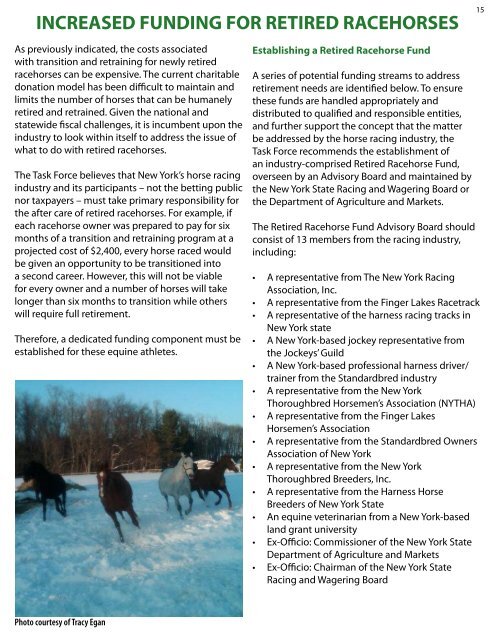Retired Racehorses
tfrr_reportandappendicesfinal
tfrr_reportandappendicesfinal
- No tags were found...
You also want an ePaper? Increase the reach of your titles
YUMPU automatically turns print PDFs into web optimized ePapers that Google loves.
INCREASED FUNDING FOR RETIRED RACEHORSES<br />
15<br />
As previously indicated, the costs associated<br />
with transition and retraining for newly retired<br />
racehorses can be expensive. The current charitable<br />
donation model has been difficult to maintain and<br />
limits the number of horses that can be humanely<br />
retired and retrained. Given the national and<br />
statewide fiscal challenges, it is incumbent upon the<br />
industry to look within itself to address the issue of<br />
what to do with retired racehorses.<br />
The Task Force believes that New York’s horse racing<br />
industry and its participants – not the betting public<br />
nor taxpayers – must take primary responsibility for<br />
the after care of retired racehorses. For example, if<br />
each racehorse owner was prepared to pay for six<br />
months of a transition and retraining program at a<br />
projected cost of $2,400, every horse raced would<br />
be given an opportunity to be transitioned into<br />
a second career. However, this will not be viable<br />
for every owner and a number of horses will take<br />
longer than six months to transition while others<br />
will require full retirement.<br />
Therefore, a dedicated funding component must be<br />
established for these equine athletes.<br />
Establishing a <strong>Retired</strong> Racehorse Fund<br />
A series of potential funding streams to address<br />
retirement needs are identified below. To ensure<br />
these funds are handled appropriately and<br />
distributed to qualified and responsible entities,<br />
and further support the concept that the matter<br />
be addressed by the horse racing industry, the<br />
Task Force recommends the establishment of<br />
an industry-comprised <strong>Retired</strong> Racehorse Fund,<br />
overseen by an Advisory Board and maintained by<br />
the New York State Racing and Wagering Board or<br />
the Department of Agriculture and Markets.<br />
The <strong>Retired</strong> Racehorse Fund Advisory Board should<br />
consist of 13 members from the racing industry,<br />
including:<br />
• A representative from The New York Racing<br />
Association, Inc.<br />
• A representative from the Finger Lakes Racetrack<br />
• A representative of the harness racing tracks in<br />
New York state<br />
• A New York-based jockey representative from<br />
the Jockeys’ Guild<br />
• A New York-based professional harness driver/<br />
trainer from the Standardbred industry<br />
• A representative from the New York<br />
Thoroughbred Horsemen’s Association (NYTHA)<br />
• A representative from the Finger Lakes<br />
Horsemen’s Association<br />
• A representative from the Standardbred Owners<br />
Association of New York<br />
• A representative from the New York<br />
Thoroughbred Breeders, Inc.<br />
• A representative from the Harness Horse<br />
Breeders of New York State<br />
• An equine veterinarian from a New York-based<br />
land grant university<br />
• Ex-Officio: Commissioner of the New York State<br />
Department of Agriculture and Markets<br />
• Ex-Officio: Chairman of the New York State<br />
Racing and Wagering Board<br />
Photo courtesy of Tracy Egan


